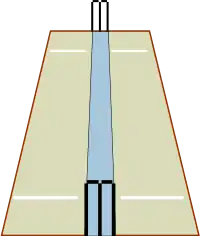Ground (cricket)
In cricket, a ground is a location where cricket matches are played, comprising a cricket field and any associated buildings and amenities.
.jpg.webp)
A batsman's ground is the area behind the popping crease at their end of the pitch. It is one of the two safe zones that batsmen run between to score runs.
Location for matches
In addition to the cricket field, the ground may include a pavilion, viewing areas or stadium, a car park, shops, bars, floodlights, sight screens, gates, and conference facilities.[1][2][3]
Parts of the pitch

A batsman's ground is the area behind the popping crease at his end of the pitch. In general, a ground belongs only to the batsman who is closest to it, and stays so until the other batsman gets closer to it. [4]
Whether a batsman is in or out of his ground is defined by Law 30 of the Laws of Cricket.[5] So long as the batsman has his body or his bat (that he is holding) touching the ground, he is in it, and is said to have "made good his ground".[6]
Batsmen can run between the two grounds to score runs. However, if a batsman is out of his ground (which can happen when he enters a ground that another batsman is already occupying), he may be dismissed (prevented from further scoring) by being run out or stumped if the wicket in his ground is put down by the ball.
References
- "Lord's Ground Map". Retrieved 29 July 2019.
- "Edgbaston - Around the ground". Retrieved 29 July 2019.
- "The County Ground, Beckenham". Retrieved 29 July 2019.
- A batsman who is in one ground can be considered to be the same distance away from the other ground as the distance between the grounds.
- "Law 30, Batsman out of his/her ground". Retrieved 29 July 2019.
- "Cricket - Runs". Encyclopedia Britannica. Retrieved 2020-12-13.